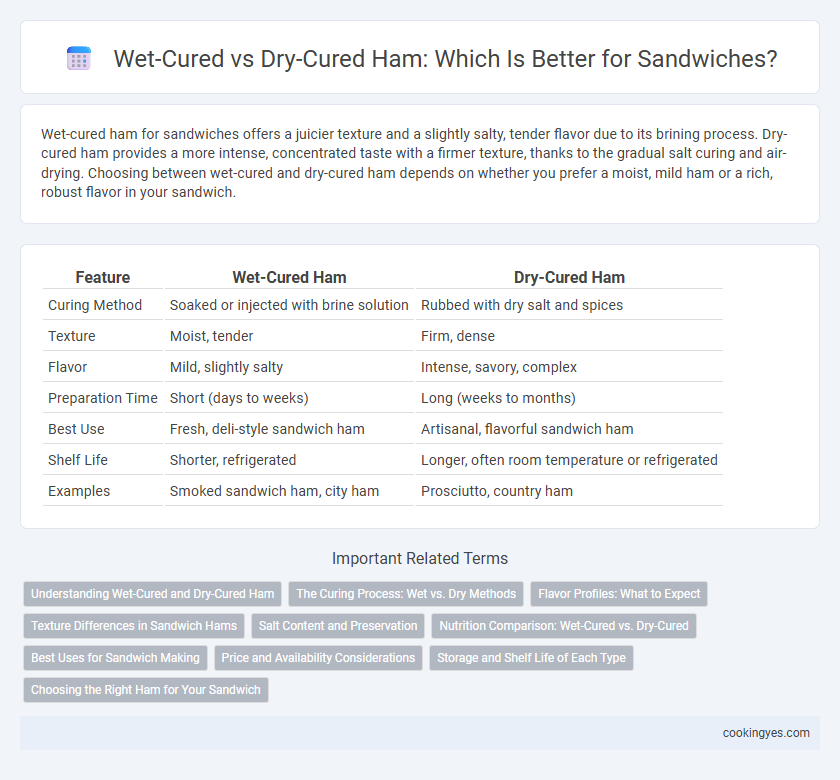Wet-cured ham for sandwiches offers a juicier texture and a slightly salty, tender flavor due to its brining process. Dry-cured ham provides a more intense, concentrated taste with a firmer texture, thanks to the gradual salt curing and air-drying. Choosing between wet-cured and dry-cured ham depends on whether you prefer a moist, mild ham or a rich, robust flavor in your sandwich.
Table of Comparison
| Feature | Wet-Cured Ham | Dry-Cured Ham |
|---|---|---|
| Curing Method | Soaked or injected with brine solution | Rubbed with dry salt and spices |
| Texture | Moist, tender | Firm, dense |
| Flavor | Mild, slightly salty | Intense, savory, complex |
| Preparation Time | Short (days to weeks) | Long (weeks to months) |
| Best Use | Fresh, deli-style sandwich ham | Artisanal, flavorful sandwich ham |
| Shelf Life | Shorter, refrigerated | Longer, often room temperature or refrigerated |
| Examples | Smoked sandwich ham, city ham | Prosciutto, country ham |
Understanding Wet-Cured and Dry-Cured Ham
Wet-cured ham involves soaking the meat in a brine solution, which enhances moisture retention and results in a tender, juicy texture ideal for sandwich ham. Dry-cured ham is coated with a mixture of salt and spices, then aged for weeks or months, intensifying its flavor and yielding a firmer, more concentrated taste. Choosing between wet-cured and dry-cured ham depends on desired moisture levels and flavor intensity, with wet-cured offering mildness and softness, while dry-cured provides robust, savory characteristics.
The Curing Process: Wet vs. Dry Methods
Wet-cured ham involves submerging the meat in a brine solution containing water, salt, sugar, and curing agents, which penetrates quickly to enhance moisture retention and tenderness. Dry-cured ham is coated with a mixture of salt and spices, allowing natural enzymes to break down proteins over weeks or months, creating a more concentrated, intense flavor and firmer texture. The choice between wet and dry curing significantly influences the ham's taste profile, texture, and suitability for sandwich preparation.
Flavor Profiles: What to Expect
Wet-cured sandwich ham offers a moist, tender texture with a mildly salty and slightly sweet flavor due to brining solutions infused with sugar, salt, and spices. Dry-cured ham develops a more intense, concentrated flavor profile characterized by a firm texture and complex savory notes from prolonged air-drying and natural enzymatic processes. Choosing between wet-cured and dry-cured ham depends on preference for subtle juiciness versus robust, nuanced taste in sandwich applications.
Texture Differences in Sandwich Hams
Wet-cured sandwich hams typically feature a moist, tender texture due to the brine infusion process, which helps retain moisture throughout cooking. Dry-cured sandwich hams develop a firmer, denser texture as the curing process involves salt and air drying, intensifying flavor and creating a slightly chewy bite. The choice between wet-cured and dry-cured hams significantly impacts mouthfeel, with wet-cured offering softness suitable for delicate sandwiches and dry-cured delivering a robust chew ideal for hearty, flavorful bites.
Salt Content and Preservation
Wet-cured sandwich ham contains higher moisture levels and salt content due to brining, which enhances its juiciness but results in a milder saltiness compared to dry-cured ham. Dry-cured ham undergoes a slow curing process with salt that draws out moisture, concentrating salt and flavor while providing longer preservation through dehydration. Salt acts as a preservative by inhibiting microbial growth, with dry-cured hams typically having a stronger salt taste and extended shelf life versus wet-cured varieties.
Nutrition Comparison: Wet-Cured vs. Dry-Cured
Wet-cured ham typically contains higher sodium levels due to the brining process, which can impact cardiovascular health if consumed excessively, while dry-cured ham generally retains more protein and has lower moisture content, enhancing its nutrient density. The moisture loss in dry-curing concentrates flavors and nutrients such as iron and zinc, making it a richer source of essential minerals compared to wet-cured alternatives. Both types provide valuable protein, but wet-cured ham often contains added sugars and preservatives that can affect its overall caloric and nutritional profile.
Best Uses for Sandwich Making
Wet-cured ham, known for its moist texture and mild flavor, absorbs brine solutions that make it ideal for juicy, tender sandwich slices. Dry-cured ham offers a firmer, more intense taste with a chewy consistency, adding robust flavor to gourmet sandwiches. For sandwich making, wet-cured ham suits classic deli-style options, while dry-cured varieties enhance artisanal and specialty sandwiches.
Price and Availability Considerations
Wet-cured sandwich ham generally offers a lower price point due to faster production processes and higher moisture content, making it more widely available in supermarkets and deli sections. Dry-cured ham tends to be pricier because of its longer curing time and artisanal method, resulting in limited availability primarily in specialty stores or gourmet markets. Consumers seeking affordable and easily accessible sandwich ham usually find wet-cured options more practical.
Storage and Shelf Life of Each Type
Wet-cured ham for sandwiches typically offers a shorter shelf life, lasting about 5 to 7 days when refrigerated, due to its higher moisture content which promotes bacterial growth. Dry-cured ham, on the other hand, benefits from lower moisture levels and salt penetration, enabling storage for several weeks under refrigeration without significant quality loss. Properly vacuum-sealed dry-cured ham can even be stored for months, making it a preferred choice for longer-lasting sandwich options.
Choosing the Right Ham for Your Sandwich
Wet-cured ham, soaked in brine for enhanced moisture and tenderness, offers a juicier bite ideal for sandwiches requiring a soft texture. Dry-cured ham undergoes a salt-rubbing process that intensifies its flavor and creates a firmer, more robust meat perfect for hearty, flavorful sandwich layers. Selecting between wet-cured and dry-cured ham depends on your preference for texture and taste, with wet-cured lending sweetness and moisture, while dry-cured delivers savory depth and chewiness.
Wet-cured vs dry-cured for sandwich ham Infographic

 cookingyes.com
cookingyes.com